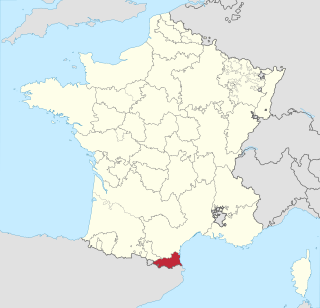
Roussillon is a historical province of France that largely corresponded to the County of Roussillon and part of the County of Cerdagne of the former Principality of Catalonia. It is part of the region of Northern Catalonia or French Catalonia, corresponding roughly to the present-day southern French département of Pyrénées-Orientales in the former region of Languedoc-Roussillon.

The Kingdom of Majorca was a realm on the east coast of Spain, including certain Mediterranean islands, and founded by James I of Aragon, also known as James The Conqueror. In a will written in 1262 after the death of his firstborn son Alfonso, he ceded the kingdom to his son James. The disposition was maintained during successive versions of his will and so when James I died in 1276, the Crown of Aragon passed to his eldest son Peter, known as Peter III of Aragon or Peter the Great. The Kingdom of Majorca passed to James, who reigned under the name of James II of Majorca. After 1279, Peter III of Aragon established that the king of Majorca was a vassal to the king of Aragon. The title continued to be employed by the Aragonese and Spanish monarchs until its dissolution by the 1715 Nueva Planta decrees.
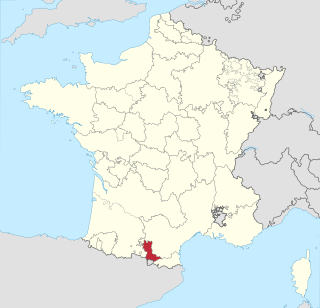
The County of Foix was an independent medieval fief in southern France, and later a province of France, whose territory corresponded roughly the eastern part of the modern département of Ariège.

The County of Empúries, also known as the County of Ampurias, was a medieval county centred on the town of Empúries and enclosing the Catalan region of Peralada. It corresponds to the historic comarca of Empordà.
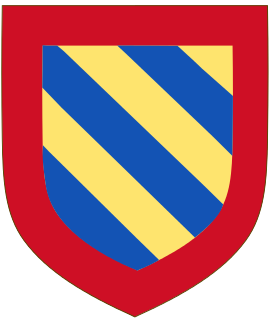
The House of Burgundy was a cadet branch of the Capetian dynasty, descending from Robert I, Duke of Burgundy, a younger son of Robert II of France. The House ruled the Duchy of Burgundy from 1032–1361.

The County of Roussillon was one of the Catalan counties in the Marca Hispanica during the Middle Ages. The rulers of the county were the counts of Roussillon, whose interests lay both north and south of the Pyrenees.
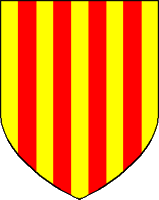
This is a list of the counts of Roussillon who ruled over the eponymous County of Roussillon.
Giselbert I, count of Roussillon (991–1013), was the son of Gausfred I. His father divided his lands between his sons, giving Ampurias to Hugh and Roussillon to Giselbert.
Gausfred II was the count of Roussillon from 1013 or 1014 to his death. He was the son and successor of Count Giselbert I, who was also count of Empúries, and Beliarda.

Sancho, also spelled Sanç or Sanche, was a Catalano-Aragonese nobleman and statesman, the youngest son of Queen Petronilla of Aragon and Count Raymond Berengar IV of Barcelona. He was at different times the count of Cerdanya (c.1175–1188), Provence (1181–1185), Gévaudan, Rodez and Carlat (1183–1185), and Roussillon (1208–1212). He served as the regent of Provence from 1209 until 1218 during the minority of Count Raymond Berengar IV, and as regent of Aragon from 1214 until 1218, during the minority of King James I.
Gerard I, called Guinard, was the count of Roussillon from 1102 to his murder in 1113. He was the son and heir of Giselbert II.
Gerard II was the last de facto independent count of Roussillon from 1164 to his death in 1172. He was the son and heir of Gausfred III.
Hugh I, Count of Empúries (Ampurias) from 991, was the son of Gausfred I and his first wife, Ava, daughter of Raymond II of Rouergue.
The County of Cerdanya was one of the Catalan counties formed in the last decades of the 8th century by the Franks in the Marca Hispanica. The original Cerdanya consisted of the valley of the upper Segre. Today Cerdanya is a Catalan comarca.

Geoffrey I or Josfred was the joint Count of Provence with his elder brothers William IV and Fulk from 1018 to his death. He was the third son of William II of Provence and Gerberga of Burgundy and a scion of the younger line of the family. It is possible that he did not carry the title "count" until after the death of his eldest brother William around 1032.
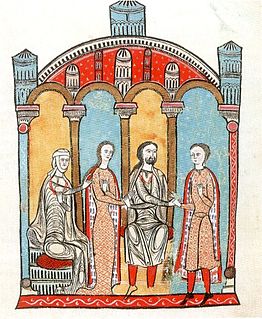
Bernard Ato IV was the Viscount of Nîmes of the Trencavel family from 1074 to his death. Bernard Ato was the son of Raymond Bernard of Nîmes and Ermengarde of Carcassonne.
ErmengolI (974–1010), called el de Córdoba, was the Count of Urgell from 992 to his death. He was the second son of Borrell II of Barcelona and his first wife, Letgarda. He was the second of the counts of Urgel and famous mainly for his participation in the Reconquista.

The Liber feudorum Ceritaniae is, as its Latin title indicates, a book registering the fiefs (feudi) within the counties of Cerdagne (Ceritania), Roussillon and Conflent, and the feudal obligations of the count and his vassals. It is preserved in the Arxiu de la Corona d'Aragó and consists of 272 charters in 379 folios with 32 colourful miniatures on a golden background. It was probably originally copied from a part of the Liber feudorum maior (LFM), which is several decades older. It contains all the documents pertaining to Cerdagne and Roussillon found in the LFM and in exactly the same order, as well as six documents more. Most of the charters in it cover the years 1172–6.

Bernard I, called Taillefer, was the Count of Besalú in Catalonia from 988 until his death. He was the eldest son of Oliba Cabreta and Ermengard of Empúries, and succeeded his father in Besalú while his younger brothers Oliba and Wifred, inherited Berga–Ripoll and Cerdagne–Conflent, respectively.
The army of Hugh the Great was formed after the Council of Clermont, led by Pope Urban II in November 1095. Hugh, son of Henry I of France, and his wife Anne of Kiev, was Count of Vermandois, de jure uxoris, due to his marriage to Adelaide of Vermandois. In August 1096, Hugh and his small army left France in prima profectione, the first army of the third wave to leave France, and travelled to Bari, Italy, and then crossed the Adriatic Sea to the Byzantine Empire, in an armada commanded by Arnout II, Count of Aarschot. When Hugh entered Constantinople, he carried a Vexillum sancti Petri, a banner given to him by the pope, Hugh being the last such noble to carry the banner.












